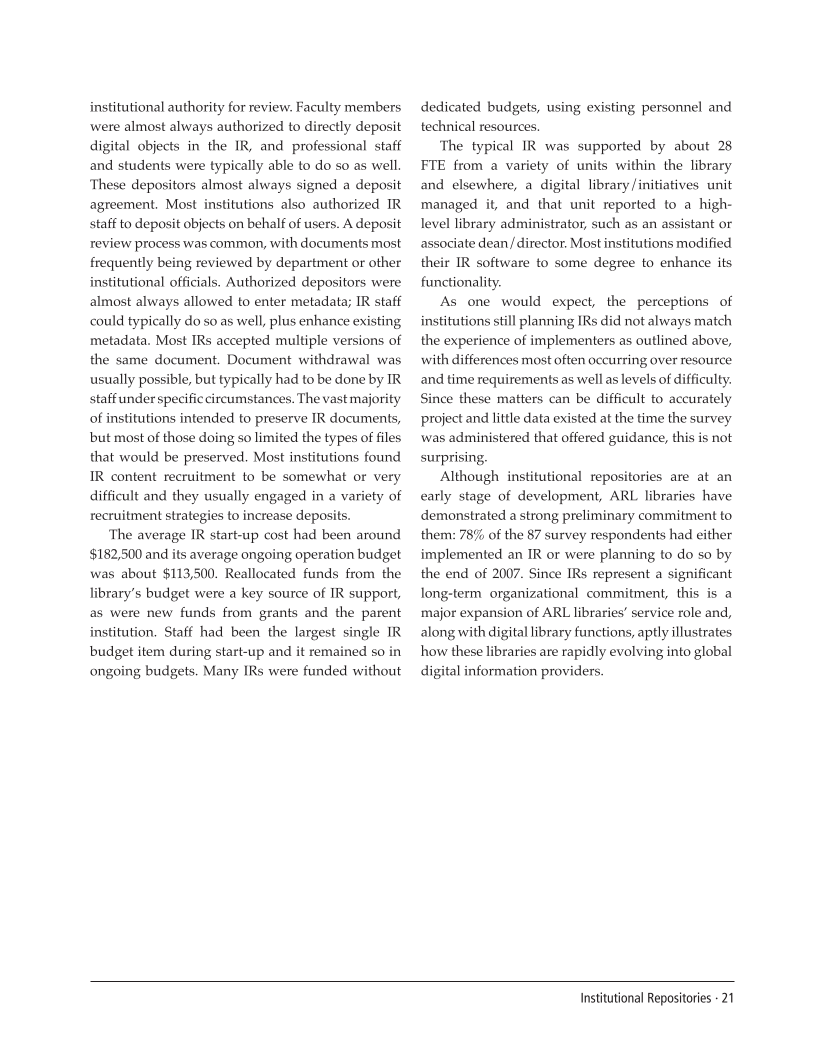Institutional Repositories · 21
institutional authority for review. Faculty members
were almost always authorized to directly deposit
digital objects in the IR, and professional staff
and students were typically able to do so as well.
These depositors almost always signed a deposit
agreement. Most institutions also authorized IR
staff to deposit objects on behalf of users. A deposit
review process was common, with documents most
frequently being reviewed by department or other
institutional officials. Authorized depositors were
almost always allowed to enter metadata IR staff
could typically do so as well, plus enhance existing
metadata. Most IRs accepted multiple versions of
the same document. Document withdrawal was
usually possible, but typically had to be done by IR
staff under specific circumstances. The vast majority
of institutions intended to preserve IR documents,
but most of those doing so limited the types of files
that would be preserved. Most institutions found
IR content recruitment to be somewhat or very
difficult and they usually engaged in a variety of
recruitment strategies to increase deposits.
The average IR start-up cost had been around
$182,500 and its average ongoing operation budget
was about $113,500. Reallocated funds from the
library’s budget were a key source of IR support,
as were new funds from grants and the parent
institution. Staff had been the largest single IR
budget item during start-up and it remained so in
ongoing budgets. Many IRs were funded without
dedicated budgets, using existing personnel and
technical resources.
The typical IR was supported by about 28
FTE from a variety of units within the library
and elsewhere, a digital library/initiatives unit
managed it, and that unit reported to a high-
level library administrator, such as an assistant or
associate dean/director. Most institutions modified
their IR software to some degree to enhance its
functionality.
As one would expect, the perceptions of
institutions still planning IRs did not always match
the experience of implementers as outlined above,
with differences most often occurring over resource
and time requirements as well as levels of difficulty.
Since these matters can be difficult to accurately
project and little data existed at the time the survey
was administered that offered guidance, this is not
surprising.
Although institutional repositories are at an
early stage of development, ARL libraries have
demonstrated a strong preliminary commitment to
them: 78% of the 87 survey respondents had either
implemented an IR or were planning to do so by
the end of 2007. Since IRs represent a significant
long-term organizational commitment, this is a
major expansion of ARL libraries’ service role and,
along with digital library functions, aptly illustrates
how these libraries are rapidly evolving into global
digital information providers.
institutional authority for review. Faculty members
were almost always authorized to directly deposit
digital objects in the IR, and professional staff
and students were typically able to do so as well.
These depositors almost always signed a deposit
agreement. Most institutions also authorized IR
staff to deposit objects on behalf of users. A deposit
review process was common, with documents most
frequently being reviewed by department or other
institutional officials. Authorized depositors were
almost always allowed to enter metadata IR staff
could typically do so as well, plus enhance existing
metadata. Most IRs accepted multiple versions of
the same document. Document withdrawal was
usually possible, but typically had to be done by IR
staff under specific circumstances. The vast majority
of institutions intended to preserve IR documents,
but most of those doing so limited the types of files
that would be preserved. Most institutions found
IR content recruitment to be somewhat or very
difficult and they usually engaged in a variety of
recruitment strategies to increase deposits.
The average IR start-up cost had been around
$182,500 and its average ongoing operation budget
was about $113,500. Reallocated funds from the
library’s budget were a key source of IR support,
as were new funds from grants and the parent
institution. Staff had been the largest single IR
budget item during start-up and it remained so in
ongoing budgets. Many IRs were funded without
dedicated budgets, using existing personnel and
technical resources.
The typical IR was supported by about 28
FTE from a variety of units within the library
and elsewhere, a digital library/initiatives unit
managed it, and that unit reported to a high-
level library administrator, such as an assistant or
associate dean/director. Most institutions modified
their IR software to some degree to enhance its
functionality.
As one would expect, the perceptions of
institutions still planning IRs did not always match
the experience of implementers as outlined above,
with differences most often occurring over resource
and time requirements as well as levels of difficulty.
Since these matters can be difficult to accurately
project and little data existed at the time the survey
was administered that offered guidance, this is not
surprising.
Although institutional repositories are at an
early stage of development, ARL libraries have
demonstrated a strong preliminary commitment to
them: 78% of the 87 survey respondents had either
implemented an IR or were planning to do so by
the end of 2007. Since IRs represent a significant
long-term organizational commitment, this is a
major expansion of ARL libraries’ service role and,
along with digital library functions, aptly illustrates
how these libraries are rapidly evolving into global
digital information providers.
















































































































































































